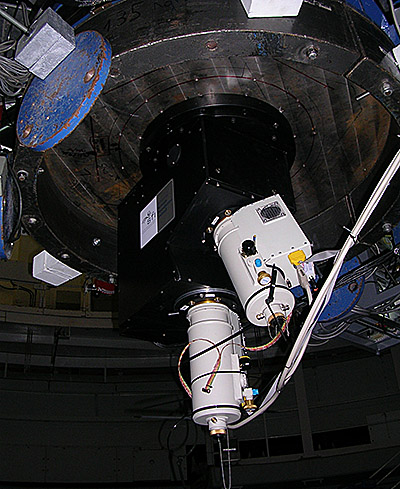First light (at ING): 25 Mar 2010.
Description:
The Galway Astronomical Stokes Polarimeter (GASP) is an ultra-high-speed, full Stokes, astronomical
imaging polarimeter based upon Division of Amplitude Polarimetry, Collins et al (2013). It has been
developed to resolve extremely rapid stochastic (~ms) variations in objects such as optical pulsars,
RRATs, magnetic cataclysmic variables and brown dwarfs. GASP has no moving parts or modulated
components, so the complete Stokes vector can be measured from just one exposure - so making it
unique to astronomy - and the time required for the determination of the full Stokes vector is limited
only by instrument QE and photon fluxes. GASP utilises a modified Fresnel rhomb, which acts as a
highly achromatic quarter wave plate and a beamsplitter, 36% of the incoming beam is initially split by
the first surface of the prism. This contains most of the linear information of the Stokes vector. After two
internal reflections to add a quarter wave of phase, the circular component is converted to linear which
can be examined, this portion of the beam also contains 36% of the incoming light. A remaining 18% of
the light is extracted for finding or guiding. Two Wollaston prisms are used to split each of the
polarimetry beams and each individual beam is picked off to either 4 individual APD modules or 2 iXon
detectors. The overall quantum efficiency (DQE) of each beam is 7% (measured). We have used this
DQE in our SNR calculations. For these observations we shall use the iXons. The iXon have a full
frame time resolution of 20 ms and can operate in partial frame readout with a frame time down to 200
microseconds; here we will be working at 500-600 microsecond frame times.
Polarimeters are among
the hardest instruments to calibrate in astronomy. The basic calibration method of current polarimeters
is to measure the amount of instrumental polarisation and subtract it from the data. This means that the
polarimeter must be designed to have the analyser as soon as possible in the light path as other
elements may depolarise the input. GASP works by purposely polarising the light before the analysers
so a different calibration method is used - Eigenvalue Calibration Method (ECM), Compain et al(1999).
A Polarisation State Generator (PSG), built into GASP, generates four linearly independent, optimised,
Stokes vectors which are measured in the lab, ( Azzam et al (1988), Compain et al (1999)). The PSG
vectors are passed through the system and four respective intensity vectors are recorded. No
instrumental polarisation will exist as this is a total polarimeter, and this has been calibrated out, but
telescope polarisation still exists and will be subtracted later. The calibration is verified by measuring
polarisation and zero polarisation standard stars. Calibration will be performed on each night on a
selection of polarisation standards. These calibrations will take approximately 1-2 hours / night and can
be performed under moonlight conditions. Internal calibrations take roughly 10 minutes and will be
performed before and after observations. Systematic errors from the ECM method in GASP are better
than 0.5%, Compain et al (1999) and Collins et al (2013)
Time allocations:
Nights scheduled since semester 2007B
Instrument information: http://astro.nuigalway.ie/research.php?id=4
Research impact:
Publications (1 from ING paper count)



